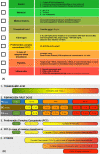Simplified treatment algorithm for the management of trauma-induced hemorrhage without viscoelastic testing
- PMID: 34337159
- PMCID: PMC8287615
- DOI: 10.1136/tsaco-2021-000779
Simplified treatment algorithm for the management of trauma-induced hemorrhage without viscoelastic testing
Abstract
Uncontrolled bleeding after major trauma remains a significant cause of death, with up to a third of trauma patients presenting with signs of coagulopathy at hospital admission. Rapid correction of coagulopathy is therefore vital to improve mortality rates and patient outcomes in this population. Early and repeated monitoring of coagulation parameters followed by clear protocols to correct hemostasis is the recommended standard of care for bleeding trauma patients. However, although a number of treatment algorithms are available, these are frequently complex and can rely on the use of viscoelastic testing, which is not available in all treatment centers. We therefore set out to develop a concise and pragmatic algorithm to guide treatment of bleeding trauma patients without the use of point-of-care viscoelastic testing. The algorithm we present here is based on published guidelines and research, includes recommendations regarding treatment and dosing, and is simple and clear enough for even an inexperienced physician to follow. In this way, we have demonstrated that treatment protocols can be developed and adapted to the resources available, to offer clear and relevant guidance to the entire trauma team.
Keywords: algorithm; hemorrhage; hemostasis; multiple trauma.
© Author(s) (or their employer(s)) 2021. Re-use permitted under CC BY-NC. No commercial re-use. See rights and permissions. Published by BMJ.
Conflict of interest statement
Competing interests: SC has received honoraria for lectures or speakers bureau from CSL Behring; has participated on an advisory board for CSL Behring, MArS Market Access & Pricing Strategy and Shionogi; and has had a leadership or fiduciary role in other board, society, committee or advocacy groups for AMLS Germany and DBRD Germany. Medical writing support was provided by Claire Crouchley of Meridian HealthComms, Plumley, UK and funded by CSL Behring; there is no grant/award number to report.
Figures
References
-
- World Health Organization . Injuries and violence the facts. 2014. https://www.who.int/violence_injury_prevention/media/news/2015/Injury_vi....
-
- Fröhlich M, Mutschler M, Caspers M, Nienaber U, Jäcker V, Driessen A, Bouillon B, Maegele M,. TraumaRegister DGU . Trauma-Induced coagulopathy upon emergency room arrival: still a significant problem despite increased awareness and management? Eur J Trauma Emerg Surg 2019;45:115–24. 10.1007/s00068-017-0884-5 - DOI - PubMed
Publication types
LinkOut - more resources
Full Text Sources

